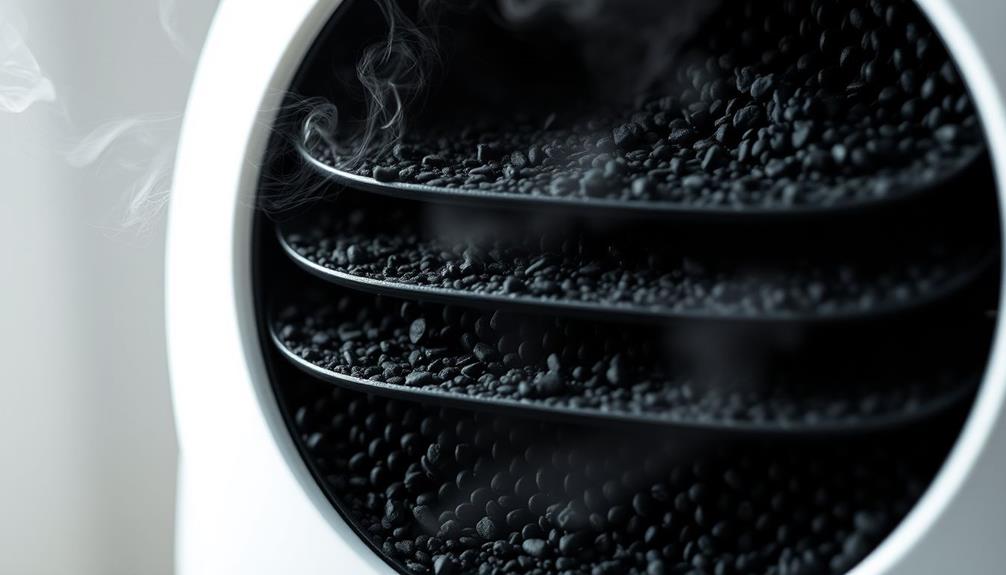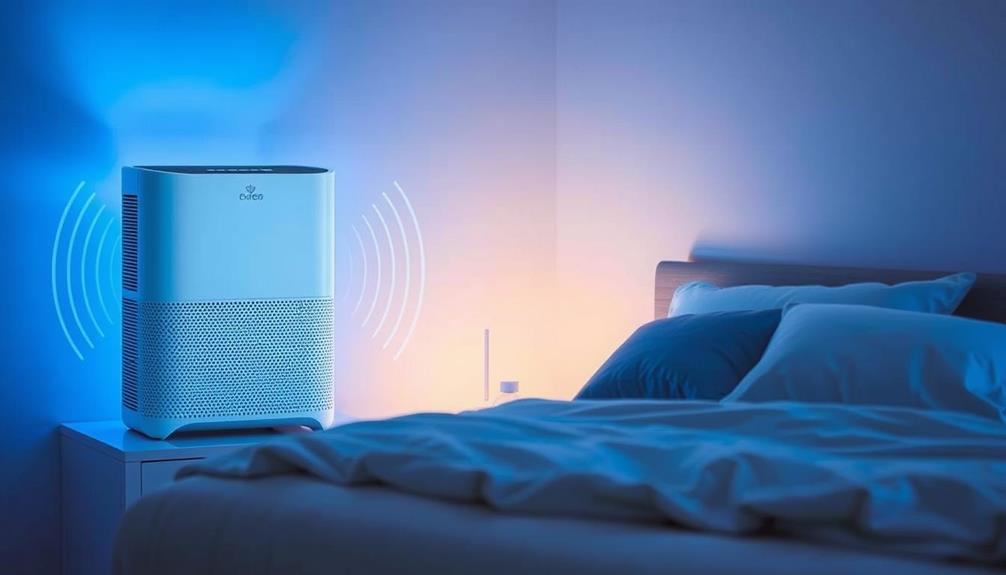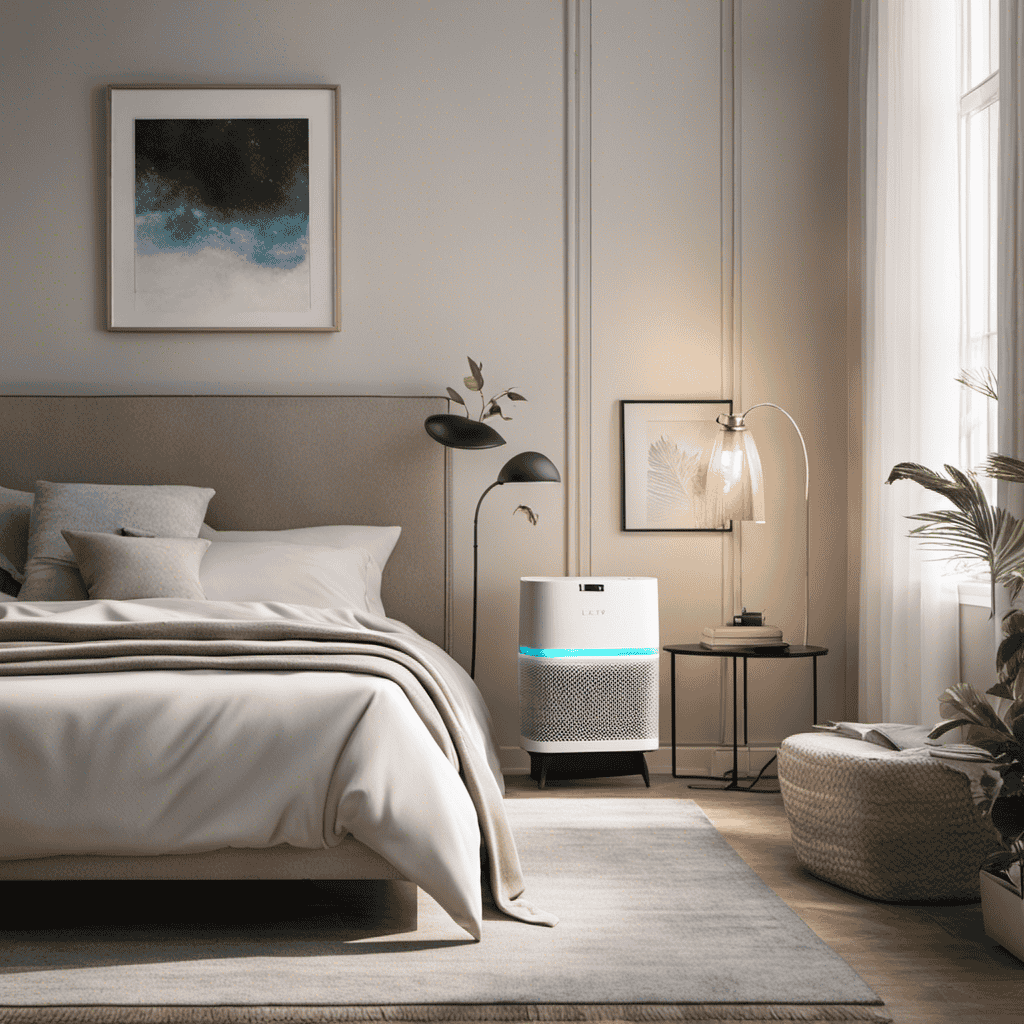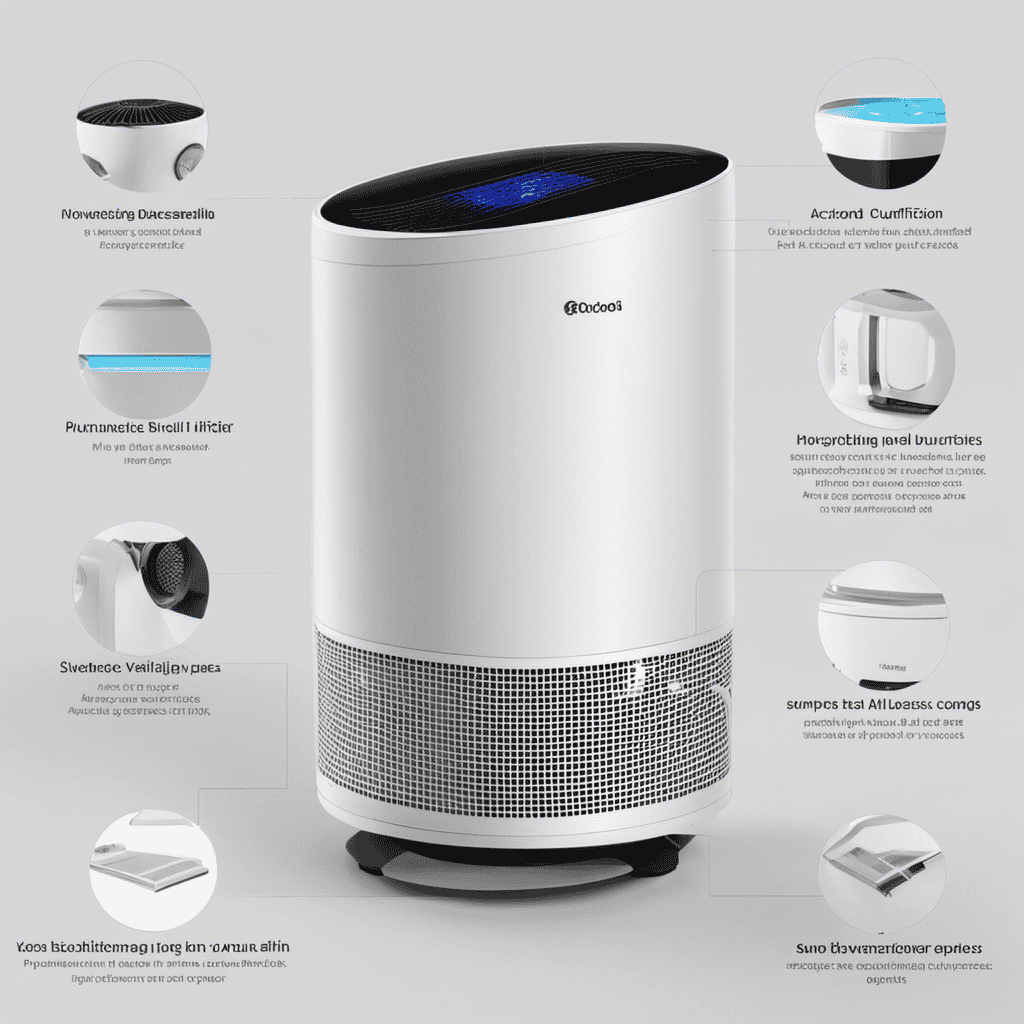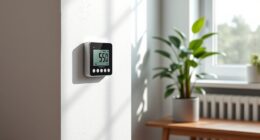Activated carbon plays a vital role in air purifiers by effectively capturing harmful pollutants and unpleasant odors that standard filters can't handle. Its porous structure allows it to adsorb volatile organic compounds (VOCs) like formaldehyde and benzene, as well as smoke odors. You'll notice a significant improvement in indoor air quality, especially if you're prone to allergies or respiratory issues. However, remember to replace the filters regularly to maintain their effectiveness, as saturation can lead to re-emission of trapped pollutants. There's a lot more to explore about air purification and how to maximize its benefits for your home.
Key Takeaways
- Activated carbon filters effectively capture volatile organic compounds (VOCs) and odors, improving indoor air quality for allergy sufferers.
- The high surface area of activated carbon allows for efficient adsorption of pollutants like formaldehyde and benzene.
- Regular filter replacements every 3 to 6 months are crucial to prevent saturation and maintain optimal performance.
- Activated carbon is cost-effective, providing long-lasting air purification solutions at lower replacement costs compared to traditional filters.
- Combining activated carbon filters with HEPA filters enhances pollutant capture, addressing both gaseous and particulate matter effectively.
Importance of Indoor Air Quality
Indoor air quality (IAQ) plays a crucial role in your overall health, often surprising many who assume the air inside their homes is cleaner than outside. In reality, indoor air can be more polluted due to everyday activities like cooking and cleaning. Common pollutants, such as volatile organic compounds (VOCs), dust, and allergens, can exacerbate respiratory issues and trigger allergies.
Utilizing ozone air purifiers can be an effective way to tackle persistent air quality issues by neutralizing harmful substances.
To combat these challenges, air purifiers with activated carbon filters have become increasingly popular. These filters effectively capture a wide range of gaseous pollutants, including cigarette smoke and cooking odors, greatly improving air quality in your home.
By utilizing the process of adsorption, activated carbon filters trap harmful substances, preventing them from circulating in your living space.
Improving your indoor air quality is essential for your health and well-being, particularly if you suffer from allergies or respiratory conditions. Investing in a quality air purifier can help you breathe easier and create a healthier environment.
Understanding Activated Carbon
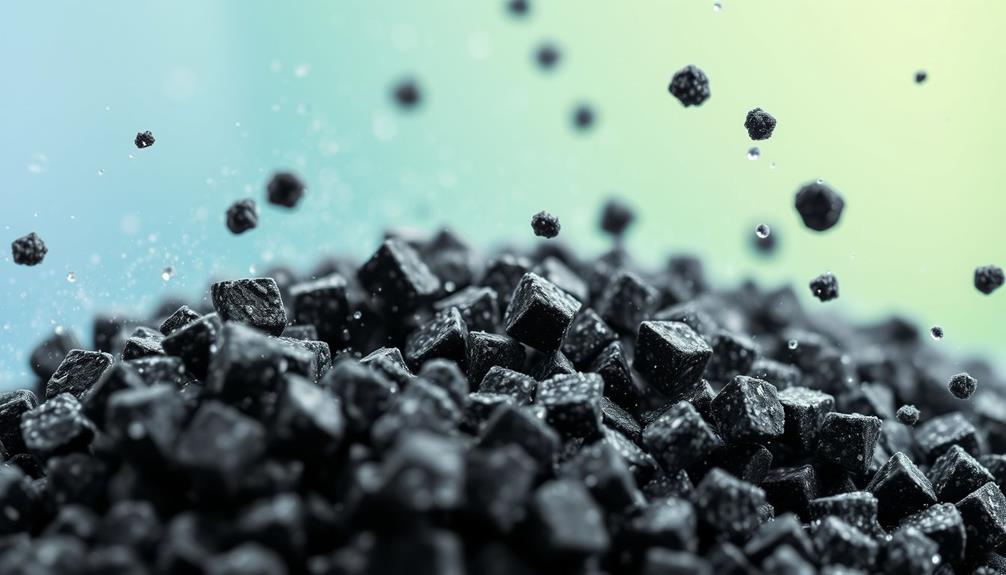
Activated carbon plays a pivotal role in air purification, thanks to its unique properties that make it an effective absorber of pollutants. Derived from materials like coconut shells, wood, and coal, activated carbon is highly porous with an extensive surface area, which allows for efficient adsorption of harmful gases and odors.
Here's a quick overview of how activated carbon works in air purifiers:
| Property | Description | Importance |
|---|---|---|
| Material Source | Coconut shells, wood, coal | Sustainable and renewable sources |
| Process of Adsorption | Pollutants adhere to the surface | Effective against VOCs |
| Surface Area | Ranges from 400 to 2,000 m² per gram | Increases pollutant capture efficiency |
| Common Pollutants | Formaldehyde, benzene, toluene | Reduces harmful indoor air quality |
| Filter Replacement | Regular replacement is essential | Maintains effectiveness |
Through the process of adsorption, activated carbon filters trap volatile organic compounds (VOCs) and other pollutants without allowing them to penetrate the carbon structure. For peak performance, remember to replace these filters regularly to avoid saturation, which can lead to decreased pollutant removal and potential re-emission of trapped gases.
Mechanism of Activated Carbon Filters

The effectiveness of activated carbon filters lies in their ability to adsorb pollutants through a process that leverages their extensive surface area. Activated carbon's highly porous structure provides a vast area for gas molecules to adhere, making it highly efficient at trapping various contaminants. With just one gram of activated carbon offering hundreds of square meters of surface, you can effectively reduce harmful substances in your indoor air.
Additionally, pet owners should be aware that regular grooming helps minimize allergens in your home, creating a more comfortable environment for both you and your dogs' health.
These filters excel at capturing volatile organic compounds (VOCs) and odors, eliminating chemicals like formaldehyde, benzene, and cigarette smoke. However, the efficiency of adsorption can vary based on environmental factors like temperature and humidity, which may affect how well the filter performs over time.
Regularly replacing your activated carbon filter is essential for maintaining air purification. As the filter reaches saturation, its ability to trap additional pollutants diminishes, and trapped contaminants can be released back into the air.
To guarantee a cleaner environment, stay on top of filter replacement schedules and monitor air quality in your space. This proactive approach helps you keep your indoor air fresh and free from harmful pollutants.
Benefits of Activated Carbon Filters

Activated carbon filters offer impressive benefits for improving your indoor air quality.
They effectively capture VOCs and pollutants, tackling odors from sources like smoke and cooking with ease.
Plus, their long lifespan makes them a cost-effective choice for maintaining fresh air in your home.
Effective Odor Removal
When you want to rid your home of unpleasant odors, activated carbon filters stand out as an effective solution. These filters excel at capturing a wide range of odors, including cooking smells, pet odors, and even cigarette smoke. Their large surface area and unique adsorption process allow them to target volatile organic compounds (VOCs) and other gaseous pollutants that contribute to poor indoor air quality.
Additionally, using air purifiers with high-quality filters can enhance the overall air purification experience.
By utilizing activated carbon, you can effectively achieve the removal of pollutants like benzene and formaldehyde, which are often found in household products and can emit unpleasant smells. The adsorption process guarantees that odorous molecules are trapped within the filter, preventing them from escaping back into your living space.
This means you can enjoy a cleaner, fresher indoor atmosphere.
However, it's essential to remember that regular replacement of activated carbon filters is necessary. Once they reach saturation, they can start re-emitting odors, which undermines their effectiveness.
VOCs and Pollutant Capture
Capturing volatile organic compounds (VOCs) is one of the standout benefits of using activated carbon filters in air purifiers.
These filters effectively trap harmful VOCs like formaldehyde, benzene, and toluene, which often lurk in household products and can be detrimental to your health.
Additionally, proper maintenance of air purification systems can enhance their effectiveness, similar to how regular plumbing maintenance can prevent clogging issues in toilets.
Here's why activated carbon is your go-to for improving indoor air quality:
- High Adsorption Capacity: Activated carbon boasts a vast surface area that allows it to adsorb a wide range of gaseous pollutants and odors.
- Chemical-Free Mechanism: It captures harmful gases without chemical reactions, making it particularly effective against tobacco smoke and cooking odors.
- Health Benefits: By considerably reducing indoor air pollution, activated carbon filters can improve air quality, especially for those with allergies or respiratory issues.
- Longevity: These filters have a long lifespan and require less frequent replacement than other filter types, ensuring ongoing VOC and odor removal.
Cost-Effective Air Quality
Cost-effectiveness is a key advantage of using activated carbon filters in air purifiers, making them a smart choice for anyone looking to improve indoor air quality without breaking the bank. These filters excel at removing volatile organic compounds (VOCs) and unpleasant odors, enhancing your comfort at home. With a lifespan that often exceeds traditional filters, activated carbon reduces the frequency and cost of replacements.
Here's a quick comparison of the benefits of activated carbon filters:
| Feature | Activated Carbon | Traditional Filters |
|---|---|---|
| Lifespan | Long-lasting | Short-lived |
| Pollutant Removal | Highly effective | Limited effectiveness |
| Cost Over Time | Cost-effective | Higher long-term costs |
Activated carbon's large surface area allows for efficient adsorption of harmful pollutants like formaldehyde, benzene, and toluene, essential for maintaining your health and well-being. Regularly replacing these filters is important to guarantee they continue to provide ideal air quality, preventing the re-release of captured pollutants. So, investing in activated carbon filters is a practical approach to cleaner air and better health.
Limitations of Activated Carbon Filters

While activated carbon filters offer many benefits, they do come with some important limitations.
For instance, they aren't designed to capture larger particles like dust or pollen, which can still affect air quality.
Additionally, they require regular replacement to maintain their effectiveness and guarantee peak performance, similar to how home security systems must be maintained for reliable operation.
If activated carbon filters become saturated, they might release pollutants back into the air, making it essential to monitor their performance.
Regular Replacement Requirement
How often should you replace your activated carbon filter? To maintain ideal air purification and guarantee your indoor air quality stays high, you should replace your activated carbon filters every 3 to 6 months.
This is particularly important as hydration strategies for your home environment can greatly enhance air quality.
Here's why regular replacement is vital:
- Saturation: As filters become saturated with pollutants, their ability to adsorb contaminants diminishes.
- Odor Return: If you notice a return of odors, it might indicate that the filter can no longer effectively remove pollutants.
- Health Risks: Continuing to use ineffective filters can lead to potential health risks due to airborne pollutants being released back into your space.
- Monitoring Filter Performance: Regularly check how well your filter is performing; if air quality declines, it's time for a change.
Limited Particle Filtration
Activated carbon filters play a significant role in improving indoor air quality, but they've limitations when it comes to particle filtration. While these filters excel at gas adsorption, targeting specific volatile organic compounds (VOCs) and odors, they fall short in capturing larger particles like dust, pollen, or pet dander. For effective removal of these particles, you'd need HEPA filters, which are specifically designed for this purpose.
Furthermore, implementing keyword clustering in your content strategy can enhance the discoverability of related articles about air purification technologies.
Additionally, the adsorption process of activated carbon filters can become less efficient in high humidity environments, where water molecules compete for adsorption sites. This can compromise their ability to effectively trap pollutants.
Regular replacement of activated carbon filters is essential; once they become saturated, they risk releasing previously captured pollutants back into your air, negatively impacting air quality.
It's important to note that the efficiency of activated carbon varies based on the quality and type of carbon used, along with the filter's design and airflow characteristics.
Consequently, while activated carbon filters are valuable for certain applications, they shouldn't be relied upon solely for thorough air purification, especially when it comes to removing particulate matter or pathogens.
Saturation Detection Challenges
Regularly, users face challenges in detecting when their activated carbon filters are saturated. Without visible indicators, it's tough to know when to replace these filters. This uncertainty can lead to decreased effectiveness in air purifiers, allowing pollutants to escape back into your living space.
Here are some key challenges:
- Humidity Impact: High humidity can fill the pores of activated carbon, considerably reducing its ability to adsorb pollutants. This is particularly important to take into account as maintaining a balanced environment is essential for overall health and well-being, including stress management techniques that can help mitigate the effects of poor air quality.
- Lack of Monitoring Tools: Without regular monitoring, you might unknowingly continue using a saturated filter, which can release trapped pollutants.
- No Standardized Assessment: There's no consistent method to assess saturation levels, leaving you unsure about your filter's effectiveness.
- Health Risks: Neglecting timely filter replacement can increase health risks due to airborne contaminants.
To maintain clean air, it's essential to stay vigilant about your filters. Regularly check them, take into account the humidity levels in your environment, and don't hesitate to replace them when in doubt.
Keeping an eye on these factors will help guarantee your air purifiers work effectively and protect your health.
Best Practices for Using Carbon Filters
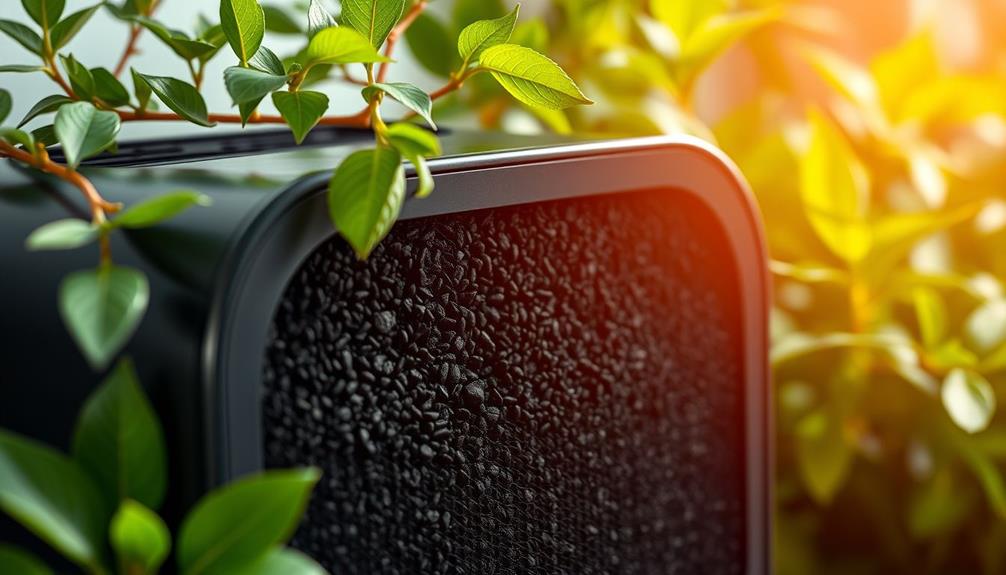
Using carbon filters effectively requires attention to several best practices that guarantee ideal air purification.
First, verify your activated carbon filters contain at least five pounds of high-quality activated carbon. This amount is vital for adequate pollutant removal and air flow.
Regularly changing filters is essential; when they become saturated, they can release odors back into the air, which diminishes their effectiveness.
Additionally, consider the impact of your HVAC system on air quality, as neglecting HVAC maintenance can lead to increased airborne pollutants and reduced efficiency.
Keep an eye on humidity levels in your environment, as high humidity can hinder the adsorption process. Water molecules can take precedence over gas pollutants, reducing your filter's performance.
To enhance air purification further, consider combining activated carbon filters with other filtration technologies, like HEPA filters. This combination effectively addresses both gaseous and particulate pollutants, providing a more thorough solution for cleaner air.
Lastly, choose filters made from reputable sources to verify you're getting activated carbon with a strong adsorption capacity.
Alternative Air Purification Solutions

When it comes to improving your indoor air quality, you might want to explore advanced filtration technologies and hybrid air purifiers.
These solutions not only combine the strengths of activated carbon with HEPA filters but also target a wider range of pollutants.
Utilizing eco-friendly methods, such as geothermal energy, can further enhance your home's sustainability while improving air quality.
Advanced Filtration Technologies
How can you guarantee the air in your home is truly clean? You might want to reflect on advanced filtration technologies that go beyond traditional methods.
Here are four options you should know about:
- Photo Electrochemical Oxidation (PECO): This cutting-edge technology actively destroys volatile organic compounds (VOCs), offering superior air quality management without the risk of reintroducing pollutants.
- Hybrid Air Purifiers: By combining activated carbon with HEPA filters, these devices capture particulate matter while targeting odors and VOCs, providing a thorough approach to indoor air pollution.
- Electrostatic Filters: Using electrically charged fibers, these filters attract and trap particles. However, they tend to require more maintenance and energy than activated carbon solutions.
- UV-C Light Technology: Incorporating UV-C light in air purifiers can enhance effectiveness by killing bacteria and viruses, working alongside activated carbon to tackle both biological and chemical pollutants.
Hybrid Air Purifiers
Combining advanced filtration technologies, hybrid air purifiers offer a powerful solution for improving indoor air quality. These devices integrate activated carbon filters and HEPA filters, effectively capturing both gaseous pollutants and particulate matter. The activated carbon's adsorption capabilities excel at removing volatile organic compounds (VOCs) and unpleasant odors, while HEPA filters efficiently target particles as small as 0.3 microns, boasting a remarkable 99.97% efficiency rate.
Many hybrid air purifiers go a step further by incorporating additional technologies like UV light or ionizers. These features help eliminate bacteria and viruses while enhancing the removal of chemical pollutants. This thorough approach makes hybrid air purifiers especially beneficial for individuals with allergies or respiratory issues, tackling various indoor air pollutants effectively.
To guarantee peak performance, regular maintenance is essential. Timely replacement of both activated carbon and HEPA filters prevents the release of trapped contaminants back into the air, maintaining a healthier environment.
Future of Air Purification Technology
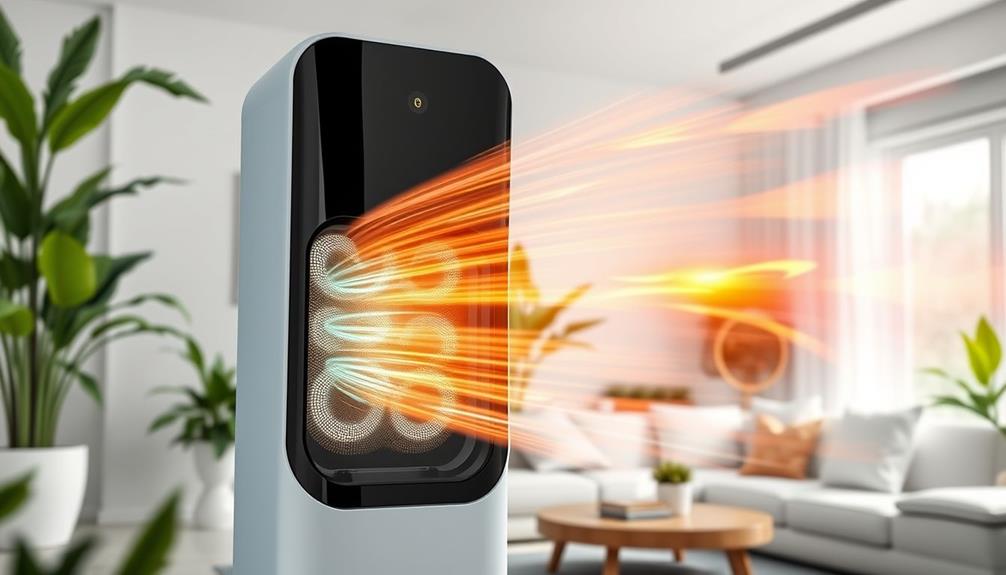
The future of air purification technology is set to revolutionize how we maintain indoor air quality, with several innovative approaches emerging on the horizon.
You'll be excited to know that advancements are being made to enhance both efficiency and sustainability in air purifiers.
Here are some key developments to watch:
- PECO Technology: This advanced method actively destroys volatile organic compounds (VOCs), rather than just capturing them, offering a significant leap in the filtration process.
- Innovations in Activated Carbon: Enhanced surface area and pore structure in activated carbon filters are improving pollutant removal capabilities.
- Smart Technology Integration: Real-time monitoring of indoor air quality and automated filter replacement notifications are becoming standard, optimizing your use of activated carbon filters.
- Hybrid Filtration Systems: The combination of activated carbon with HEPA filters is gaining traction, providing thorough pollutant removal.
With ongoing research focusing on sustainability, including bio-based materials and reactivation processes, the future of air purifiers looks not only efficient but also eco-friendly.
Embrace these innovations to guarantee your indoor air quality is better than ever!
Choosing the Right Air Purifier
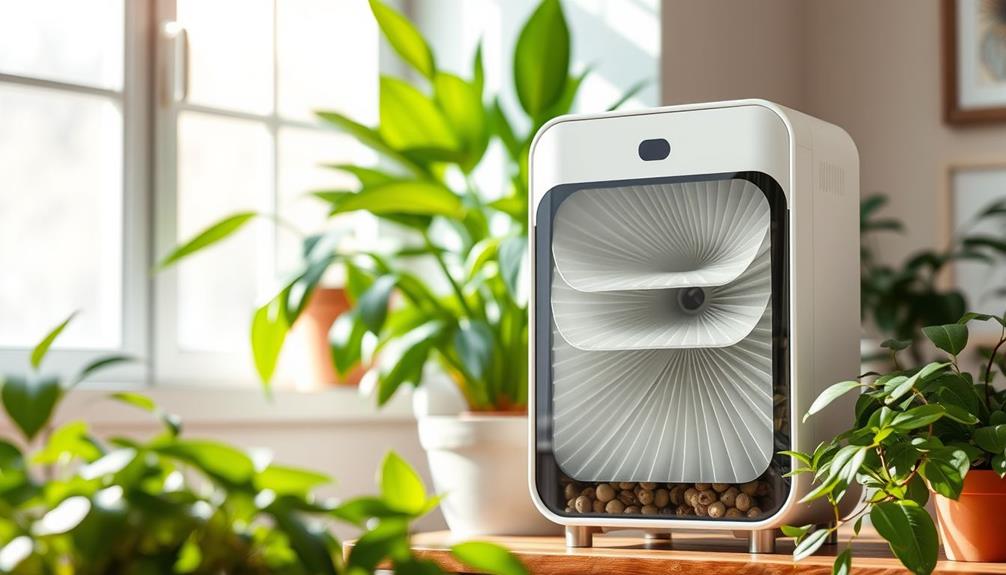
Choosing the right air purifier can greatly impact your indoor air quality. Start by confirming it includes activated carbon filters, as these are effective in capturing volatile organic compounds (VOCs) and unpleasant odors. This feature markedly enhances the air you breathe.
Next, look for an air purifier with a Clean Air Delivery Rate (CADR) that matches your room size. A higher CADR means better performance in purifying the air quickly, which is vital for maintaining a healthy environment.
Also, pay attention to the weight of the activated carbon in the filter; heavier filters typically provide more effective pollutant removal, especially for smoke and chemical fumes.
Consider hybrid air purifiers that combine HEPA and activated carbon filters. This combination addresses both particulate matter and gaseous pollutants, giving you thorough filtration.
Finally, remember that regular replacement of activated carbon filters is important, usually recommended annually based on usage. This maintenance will guarantee your air purifier remains effective and prevents the re-emission of trapped pollutants.
Common Misconceptions About Activated Carbon

When it comes to activated carbon filters, several misconceptions can lead to misunderstandings about their effectiveness. Here are some common myths you should be aware of:
- All Pollutants are Removed: Activated carbon filters are effective at removing VOCs and odors, but they don't tackle particulate matter like dust and pollen.
- No Need for Replacement: It's a misconception that these filters last forever. They require regular replacement because they can become saturated and lose their adsorption capacity.
- All Activated Carbon is Equal: The source material and activation process influence the filter's effectiveness. Not all activated carbon is created equal.
- High Humidity Isn't a Problem: Many think activated carbon handles high humidity well, but excess moisture can hinder its performance by prioritizing water molecules over harmful gases.
Understanding these misconceptions helps you make informed choices when using air purifiers.
Remember, activated carbon filters are best used alongside other types, like HEPA filters, for thorough air quality management.
Conclusion
In the grand tapestry of indoor air quality, activated carbon weaves an essential thread, capturing unwanted particles and odors with finesse. While it shines brightly in the domain of air purification, it's wise to remember its limitations and explore alternative options. As technology continues to evolve, your choice in air purifiers will only become more nuanced. So, embrace the journey toward cleaner air, and let the fresh breeze of knowledge guide your decisions for a healthier home.
